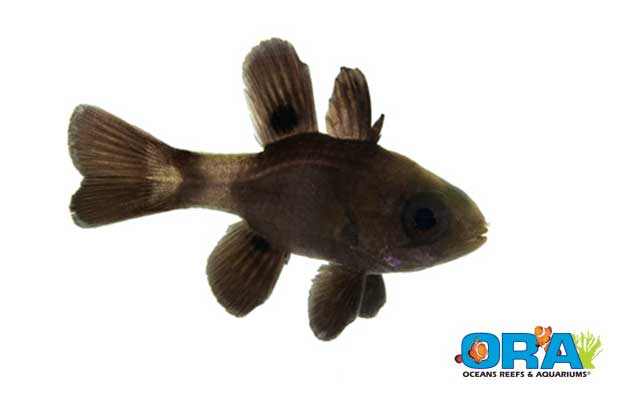ORA’s announcement of their Black Cardinfalfish may make 2013 the year of the Cardinalfish. Banggai Rescue is slated to be published, David Watson is presenting “Cardinalfish breeding beyond the Banggai” at the 2013 Marine Breeder’s Workshop, and twice this month we’ve running stories about new commercial production of non-Banggai Cardinalfish.
These species are much more difficult species to spawn and rear than the ill-named “Guppy of the marine aquarium”. ORA’s latest announcement brings the velvety black gem to market as a captive-bred fish for the first time with ORA’s introduction of Apogonichthyoides melas (one of the many cardinalfish formerly lumped into the genus Apogon).
Recent exports of this species from Papua New Guinea and other areas brought this fish to our collective attention in the past few years. Despite a rather melancholy coloration, the prospect of a solid black cardinalfish, one that will freely school and deviates from the typical aquarium aesthetic, enthralled some aquarists. While you may be familiar with this species’ adult coloration, ORA’s description of the juvenile transformation reveals a very interesting color change, a part of this species’ life history that before now may have been unknown.
“Juvenile Black Cardinalfish exhibit a white, almost translucent posterior half with a pitch black anterior half. As they mature the white color recedes to only the unpaired fins. Finally as mature adults, they lose any trace of white color and range from dark mocha to pitch black depending on their mood. This species also exhibits ocelli or eyespots at the base of the second dorsal and anal fins.”
Check out ORA’s blog for more on their latest addition to the captive bred scoreboard. All told, the totality of known captive-bred Cardinalfish species now includes Apogon compressus, A. cyanosoma, A. margaritophorus, Apogonichthyoides melas, Cheilodipterus quinquelineatus, Pterapogon kauderni, Quincia mirifica, Sphaeramia nematoptera, and Zoramia leptacantha. With potentially dozens of additional cardinalfish species occasionally available on the market, there’s still plenty of opportunity for the intrepid hobbyist to learn from these successes and claim a first of their own. We’re aware of at least one other possible species that narrowly missed being added to this list…so with 10+ months left to go, who knows what other cardinalfish breeding may occur.



